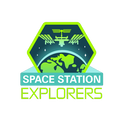January 29: Thrive Home School Academy and District 2 Schools in the Colorado Springs, CO area welcomed two NASA astronauts—Kevin Chilton and Susan Helms—to Harrison High School auditorium, for a presentation and a Q&A session for students and their families. Thrive School Academy had named January as Space Month and offered this astronaut visit, and many related activities to students. One that faculty said students really enjoyed had involved using VR headsets for a virtual tour of the ISS. The schools’ ARISS contact will be scheduled in the next few weeks.
January 31: The ARISS-Europe Team worked with Axiom Space Agency for crew member Marcus Wandt to support an ARISS radio contact for the Bilingual Montessori School of Stiftelsen in Lund, Sweden. The students had enjoyed STEM activities with help from a collaboration of ESERO Sweden, the National Museum of Science and Technology with its ham radio station, the KTH Royal Institute of Technology, and Wisdome Arenas. An audience of over 400 students ages 6 through 16 watched as fellow students asked Wandt 20 questions. They had just enough time to thank him before the radio signal quieted as the ISS traveled over the horizon. The livestream captured 982 views in 48 hours’ time and also, the National Museum of Science and Technology had streamed the event. Reps came from Sveriges TV and the newspaper Svenska Dagbladet. ESERO Sweden sent this happy message: “What good questions they [students] asked!” Students had engaged in numerous STEM and space lessons. Wandt wanted “to ignite a passion for STEM education in teachers and students worldwide to each pursue their ambitions.”
January 30: ARISS and Axiom Space agency worked together on an ARISS contact for students at Ömer Cemile Güler Imam Hatip Secondary School in Konya, Selçuklu, Türkiye. They talked with Axiom’s Alper Gezeravci, who answered 20 questions. The students ranged in age from 10 through 13 and the contact was carried out in the Turkish language. In addition to the students, 6 teachers were also present along with members of the press. With Gezeravci as the first Turkish astronaut to go to space, a representative from the attitude and orbit control group at the Space Technologies Research Institute wrote about the ARISS contact: “We truly shared a moment in history.”
January 31: Bandırma Şehit Güvenç Anatolian High School in Balikesir, Bandırma, Türkiye hosted an ARISS radio contact supported by Axiom astronaut Alper Gezeravci. Twenty students, ages 14 through 17, asked 16 questions. Then they gave him a round of applause, thanked him, and wished him a safe return home. Teachers and students attended, as did news media representatives. The contact was live streamed. Media included Sabah.com, ONCE VATAN, and AA.com. The latter’s story is at https://www.aa.com.tr/tr/bilim-teknoloji/astronot-gezeravci-konya-ve-balikesirdeki-ogrencilerle-telsizle-gorustu/3125548.
January 27: An ARISS radio contact took place for Aznakaevsky district schools in Aznakaevsky in the Republic of Tatarstan, Russia. Pupils had taken part in the About Gagarin From Space lesson series. ARISS-Russia had crew member Oleg Kononenko scheduled to support the ARISS contact.
January 25: The ARISS-Russia team led an ARISS contact and taught the About Gagarin From Space lessons for students of the Center for Children’s Technical Creativity "Young Motorist" events. This took place in Nizhny Novgorod, Russia. 15 students participated in the radio contact and the crew member for this contact was Konstantin Borisov.
ARISS Social Media metrics
ARISS social media leader Jim Reed reported January 2024 Social Media highlights:
January 31: The ARISS-Europe Team worked with Axiom Space Agency for crew member Marcus Wandt to support an ARISS radio contact for the Bilingual Montessori School of Stiftelsen in Lund, Sweden. The students had enjoyed STEM activities with help from a collaboration of ESERO Sweden, the National Museum of Science and Technology with its ham radio station, the KTH Royal Institute of Technology, and Wisdome Arenas. An audience of over 400 students ages 6 through 16 watched as fellow students asked Wandt 20 questions. They had just enough time to thank him before the radio signal quieted as the ISS traveled over the horizon. The livestream captured 982 views in 48 hours’ time and also, the National Museum of Science and Technology had streamed the event. Reps came from Sveriges TV and the newspaper Svenska Dagbladet. ESERO Sweden sent this happy message: “What good questions they [students] asked!” Students had engaged in numerous STEM and space lessons. Wandt wanted “to ignite a passion for STEM education in teachers and students worldwide to each pursue their ambitions.”
January 30: ARISS and Axiom Space agency worked together on an ARISS contact for students at Ömer Cemile Güler Imam Hatip Secondary School in Konya, Selçuklu, Türkiye. They talked with Axiom’s Alper Gezeravci, who answered 20 questions. The students ranged in age from 10 through 13 and the contact was carried out in the Turkish language. In addition to the students, 6 teachers were also present along with members of the press. With Gezeravci as the first Turkish astronaut to go to space, a representative from the attitude and orbit control group at the Space Technologies Research Institute wrote about the ARISS contact: “We truly shared a moment in history.”
January 31: Bandırma Şehit Güvenç Anatolian High School in Balikesir, Bandırma, Türkiye hosted an ARISS radio contact supported by Axiom astronaut Alper Gezeravci. Twenty students, ages 14 through 17, asked 16 questions. Then they gave him a round of applause, thanked him, and wished him a safe return home. Teachers and students attended, as did news media representatives. The contact was live streamed. Media included Sabah.com, ONCE VATAN, and AA.com. The latter’s story is at https://www.aa.com.tr/tr/bilim-teknoloji/astronot-gezeravci-konya-ve-balikesirdeki-ogrencilerle-telsizle-gorustu/3125548.
January 27: An ARISS radio contact took place for Aznakaevsky district schools in Aznakaevsky in the Republic of Tatarstan, Russia. Pupils had taken part in the About Gagarin From Space lesson series. ARISS-Russia had crew member Oleg Kononenko scheduled to support the ARISS contact.
January 25: The ARISS-Russia team led an ARISS contact and taught the About Gagarin From Space lessons for students of the Center for Children’s Technical Creativity "Young Motorist" events. This took place in Nizhny Novgorod, Russia. 15 students participated in the radio contact and the crew member for this contact was Konstantin Borisov.
ARISS Social Media metrics
ARISS social media leader Jim Reed reported January 2024 Social Media highlights:
- Impressions and Interactions were both up over January 2023.
- Facebook brought the most Impressions this month--52.8% of views.
- Posts on Axiom contacts got high interest, especially on the first Turkish crew member.
January 2024 Total Impressions and Total Interactions/Engagements
- ARISS X – Total Impressions / Views 117,902, Interactions / Engagements 3,512
- ARISS Facebook – Total Impressions / Views 145,473, Interactions / Engagements 3,227
- ARISS Total New Followers across all ARISS Social Platforms - 657
- ARISS You Tube – Total subscribers increased to 2,100
- ARISS Web pages – Unique Visits 21,336, Page Views 61,010
January Top Posts
Top X post (10,451 Impressions, 172 Engagements) about Axiom crew supporting contacts
Top Facebook post (41,169 Impressions, 457 Engagements) about NBC TODAY show’s Harry Smith interviewing Harbor Creek School students immediately after their ARISS contact
ARISS Upcoming Events
Feb 7: Lilburn Elementary School, Lilburn GA—ARISS contact, ARSS-USA Team
Feb 9: School of Telecommunications Engrg, Valencia, Spain-ARISS contact, ARISS-Europe Team
Feb 22-24: Human Spaceflight Amateur Radio: 40th Anniversary Celebration, KSC Center for Space Education, Titusville FL—ARISS conference/gala, ARISS-I Team

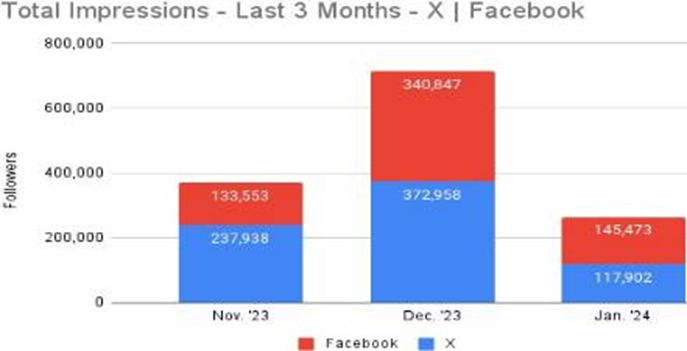
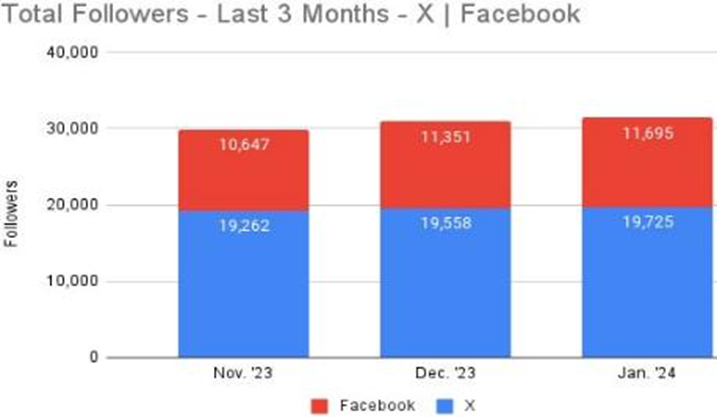
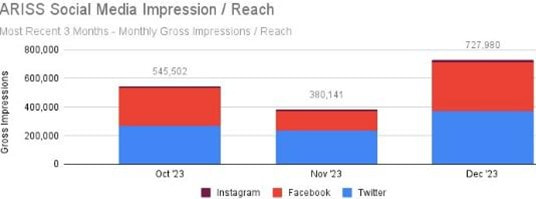

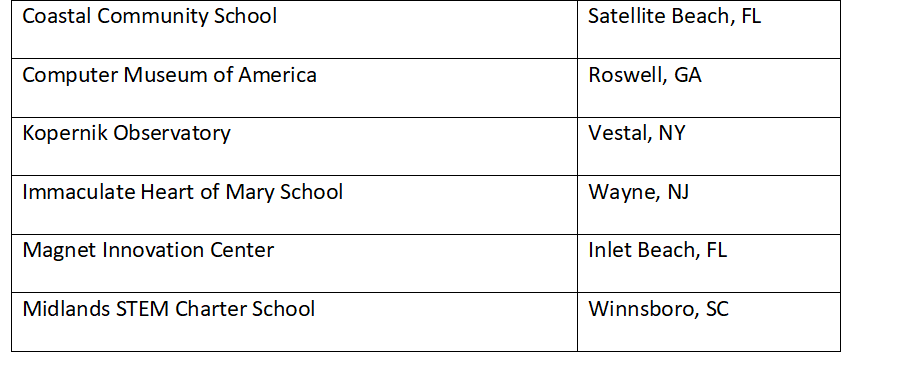


 RSS Feed
RSS Feed


